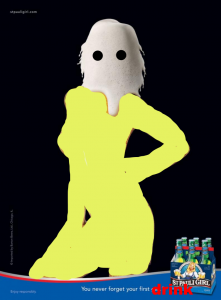Original Advertisement

Analysis of Advertisement
The people behind the advertisement are brilliant for coming up with the idea to use beer to represent women. The slogan too is genius as it stems from their original name (i.e. St. Pauli Girl’s) and it allows the audience to openly interpret whether the reference to the term girl was of their first girl or of their first beer. By doing so, it guides the audience to draw from personal experiences and thus a connection between the audience and the product itself is formed. That said, the major underlying problem with the advertisement is its objectification of women. From looking at the advertisement, we see a blatant disregard for what constitutes being a woman and as such, the advertisement shapes its beer in the form of a woman. By turning the woman into the beer or by turning the beer into the woman, it accentuates the idea that women are, simply put, just the sum of their body parts. In other words, the advertisement is using the deemed valuable physical characteristics and demeanour of women as a means to better advertise. The logo itself already showcases women with cleavage holding beer, which is an indication that beer and women, from the perspective of a certain male audience (i.e. their target market), go hand in hand with entertainment. Moreover, the woman in the advertisement even takes a large chest and strikes a modelling pose as if she were in a commercial. By the woman immersing herself as a beer in the advertisement, it demonstrates that beer and women are interchangeable. This allows the audience to draw in the gaps with their own experiences of beer and women. The advertisement is then able to connect with its audience through the very apparent objectification of women and do its entailed job, which is to sell.
Jammed Advertisement

Jamming Philosophy
The new, jammed advertisement highlights the idea that the designers of the advertisement used the brand’s name and slogan to create an advertisement almost completely based off the objectification of women. Taking a closer look at the jammed advertisement, we see that the woman now takes a pair of black eyes, that the dress is now yellow, and that the woman is now on the larger side when compared with the original advertisement. Immediately, it is apparent that the advertisement has lost its ability to market the beer and the woman as well, because of the loss in the deemed sexually appealing female characteristics. The reason being is that the black eyes staring back at the viewer suggests an aggressive look rather than a passive one, which is traditionally seen by society as less culturally appropriate for woman. The use of light yellow (because it’s a less stimulating colour) and the increase in woman size exaggerates the idea that the chic woman is now an average woman. This limits the advertisement as where the original advertisement allowed the viewer to openly interpret whether the photo was of a beer or of a woman, this jammed advertisement only displays a less appealing woman. The audience is no longer able to fill in the gaps to their imagination with their own experiences as the advertisement has lost its sexual appeal.The lines “You never forget your first drink” leads the viewer to only remember their first beer and its experience. By limiting what is left open to interpretation, it has destroyed the captivating elements of the advertisement. This is a clear indication that the advertisement was objectifying women and that its objectification of women allowed for the creation of a more engaging advertisement. The important question now is whether the original advertisement was of beer, was of woman, or was of both.
Ad source:
https://adage.com/creativity/work/st-pauli-girl-you-never-forget-your-first-girl/7216